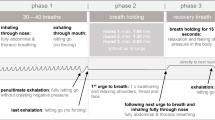Abstract
Global linear analysis has been traditionally performed to verify the relationship between pulse transit time (PTT) and systolic arterial pressure (SAP) at the level of their spontaneous beat-to-beat variabilities: PTT and SAP have been plotted in the plane (PTT,SAP) and a significant linear correlation has been found. However, this relationship is weak and in specific individuals cannot be found. This result prevents the utilization of the SAP–PTT relationship to derive arterial pressure changes from PTT measures on an individual basis. We propose a local linear approach to study the SAP–PTT relationship. This approach is based on the definition of short SAP–PTT sequences characterized by SAP increase (decrease) and PTT decrease (increase) and on their search in the SAP and PTT beat-to-beat series. This local approach was applied to PTT and SAP series derived from 13 healthy humans during incremental supine dynamic exercise (at 10, 20 and 30% of the nominal individual maximum effort) and compared to the global approach. While global approach failed in some subjects, local analysis allowed the extraction of the gain of the SAP–PTT relationship in all subjects both at rest and during exercise. When both local and global analyses were successful, the local SAP–PTT gain is more negative than the global one as a likely result of noise reduction.




Similar content being viewed by others
References
Allen RA, Schneider JA, Davidson DM, Winchester MA, Taylor CB (1981) The covariation of blood pressure and pulse transit time in hypertensive patients. Psychophysiology 18:301–306
Bertinieri G, di Rienzo M, Cavallazzi A, Ferrari AU, Pedotti A, Mancia G (1985) A new approach to analysis of the arterial baroreflex. J Hypertens 3:S79–S81
Bland M (2000) An introduction to medical statistics. Oxford University Press, New York
Bramwell J, Hill A (1922) The velocity of the pulse wave in man. Proc R Soc 93:298–306
Davies RJO, Belt PJ, Roberts SJ, Ali NJ, Stradling JR (1993) Arterial blood-pressure responses to graded transient arousal from sleep in normal humans. J Appl Physiol 74:1123–1130
Gosling R, Budge M (2003) Terminology for describing the elastic behaviour of arteries. Hypertension 41:1180–1182
Gribbin B, Steptoe A, Sleight P (1976) Pulse wave velocity as a measure of blood pressure change. Psychophysiology 13:86–90
Laude D, Elghozi JL, Girard A, Bellard F, Bouhaddi M, Castiglioni P, Cerutti C, Cividjian A, di Rienzo M, Fortrat JO, Janssen B, Karemaker JM, Leftheriotis G, Parati G, Persson PB, Porta A, Quintin L, Regnard J, Rudiger H, Stauss HM (2004) Comparison of various techniques used to estimate spontaneous baroreflex sensitivity (the EuroBaVar study). Am J Physiol 286:R226–R231
Lucini D, Dalla Vecchia L, Porta A, Malliani A, Pagani M (1997) Non-invasive assessment of the changes in static and oscillatory components of peripheral pressure/flow relationships produced by moderate exercise in humans. J Hypertens 15:1755–1760
Marie G, Lo C, van Jones J, Johnston D (1984) The relationship between arterial blood pressure and pulse transit time during dynamic and static exercise. Psychophysiology 21:521–527
Palus M (1996) Detecting nonlinearity in multivariate time series. Phys Lett A 213:138–147
Payne RA, Symeonides CN, Webb DJ, Maxwell SRJ (2006) Pulse transit time measured from the ECG: an unreliable marker of beat-to-beat blood pressure. J Appl Physiol 100:136–141
Porta A, Gasperi C, Nollo G, Lucini D, Antolini R, Pagani M (2005) Sequence analysis of pulse transit time and systolic blood pressure during dynamic exercise. In: Computers in cardiology 2005, Lyon, France, 25–28 September 2005
Smith RP, Argod J, Pepin J-L, Levy PA (1999) Pulse transit time: an appraisal of potential clinical applications. Thorax 54:452–458
Steptoe A, Smulyan H, Gribbin B (1976) Pulse wave velocity and blood pressure change: calibration and applications. Psychophysiology 15:488–493
Theiler J, Eubank S, Longtin A, Galdrikian J (1992) Testing for nonlinearity in time series: the method of surrogate data. Physica D 58:77–94
Wippermann CF, Schranz D, Huth RG (1995) Evaluation of the pulse wave pressure arrival time as a marker for blood pressure changes in critically ill infants and children. J Clin Monit 11:316–321
Author information
Authors and Affiliations
Corresponding author
Rights and permissions
About this article
Cite this article
Porta, A., Gasperi, C., Nollo, G. et al. Global versus local linear beat-to-beat analysis of the relationship between arterial pressure and pulse transit time during dynamic exercise. Med Bio Eng Comput 44, 331–337 (2006). https://doi.org/10.1007/s11517-006-0042-4
Received:
Accepted:
Published:
Issue Date:
DOI: https://doi.org/10.1007/s11517-006-0042-4




